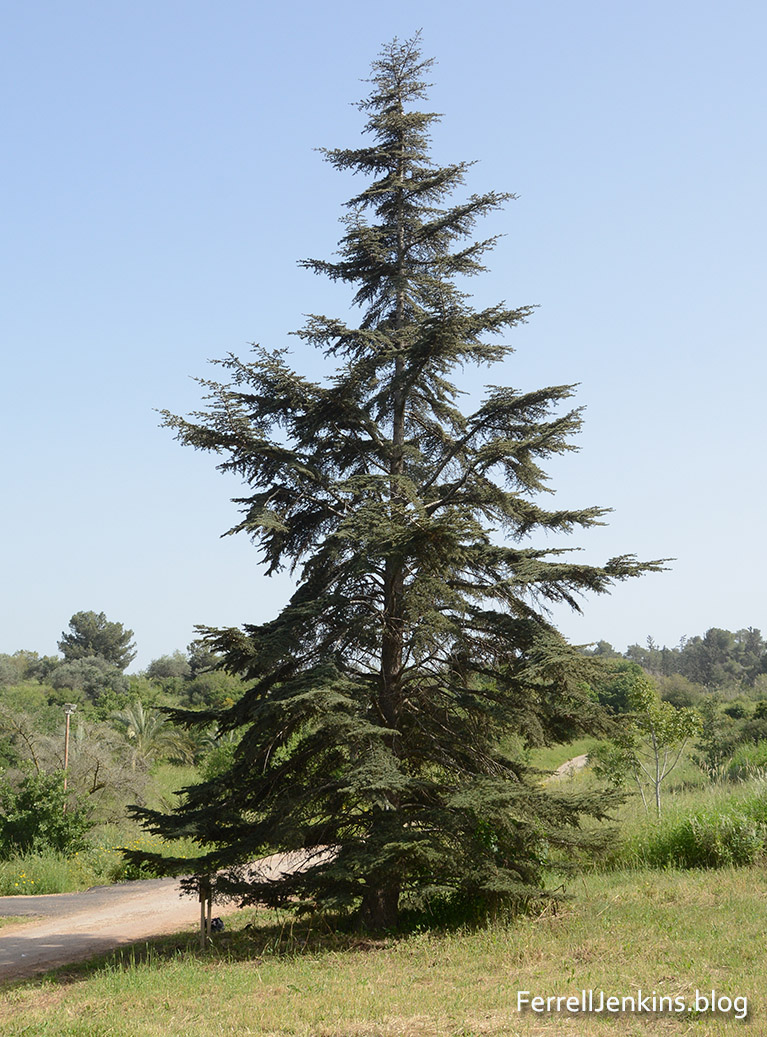My first visit to Neot Kedumim was with Leon Mauldin about 14 years ago. Neot Kedumim is a Biblical Landscape Reserve in Israel, located halfway between Jerusalem and Tel Aviv in the vicinity of Modin. One can spend several hours following one of the several trails on this 625 acres of hills and valleys. For more details visit the website here.
A few years ago I was doing some reading about the animals in the Haibar Reserve north of Eilat in the Arabah when I ran across a reference a cedar of Lebanon growing in Neot Kedumim. The article written by Helen Frenkley provides the explanation:
One of the most striking garden areas at Neot Kedumim is the Garden of Wisdom Literature, where cedars of Lebanon grow alongside clumps of hyssop bushes. Transplanting fifteen 40-year-old cedars of Lebanon to Neot Kedumim was quite an undertaking. In 1976, the trees were purchased from the Hebrew University of Jerusalem’s botanical garden on Mt. Scopus. Those cedars of Lebanon had been brought as cones from Lebanon in 1936 by Dr. Ephraim and Mrs. Hannah Hareuveni and their 12-year-old son, Nogah, after an extended botanical field trip to that country. The seeds that germinated were planted on Mt. Scopus not far from the Museum of Biblical and Talmudic Botany established by the Hareuvenis at the university in 1925. Carefully tended, these trees thrived and new seedlings were added as the years went by.
Ephraim and Hannah Hareuveni died in the 1950s without seeing the Biblical Landscape Reserve they had dreamed of creating. Mt. Scopus was cut off from western Jerusalem by Jordanian forces during the 1948 War of Independence and was inaccessible to Israelis, except for a small caretaker police force, between 1948 and 1967. In the Six Day War of 1967, Mt. Scopus became part of Israel. Nogah Hareuveni was one of the first people who returned to see how the cedars of Lebanon had weathered the near siege conditions of those 19 years. Because of the lack of drinking water on Mt. Scopus, it had been impossible to irrigate the cedars, which consequently suffered greatly.
Nine years later, however, 15 of those cedar trees were boxed. When, after eight more months, the side roots grew, confined within the four-sided slats, the tap roots were cut and the trees trucked down to Neot Kedumim. Pits with rich soil had been prepared and a water tanker stood by for immediate irrigation. Neot Kedumim is 2,000 feet lower in elevation than Mt. Scopus, but much to everyone’s surprise and delight, the diligent care paid off. The cedars survived and flourished. Several scores of saplings of various ages have now been added, so that a grove of some 50 cedars of different sizes thrives in the Garden of Wisdom Literature at Neot Kedumim.
You can find the complete article in Frenkley, Helen. “The Search for Roots—Israel’s Biblical Landscape Reserve.” Biblical Archaeology Review. Sept/Oct. 1986.
When I purchased my ticket to visit Neot Kedumim in early April I asked about the cedars. The person on duty called the office to inquire. A very nice lady came to provide the answers I needed. This time I took a trail different from the one Leon and I had taken in ’05.
It took a while, and I began to wonder if I would ever see a cedar. Eventually I came to an area where several small trees were visible.

Small Cedars of Lebanon growing at Neo Kedumim in the lowlands of Israel. Photo by Ferrell Jenkins.
After a while I came to what I think is the oldest of the Cedars. This plant is identified as a Cedrus Libani (cedar of Lebanon).

Likely the largest Cedar of Lebanon (Cedrus Libani) growing in Neot Kedumim. Photo by Ferrell Jenkins.
Not very long back we presented several articles on the Cedar of Lebanon. Begin here. If you do not easily locate others in the series, just use the Search Box and insert cedars.
I can highly recommend visits to Neot Kedumim) for travelers who have the time to visit. This year Luke Chandler traveled with me, but he had to return home a few days early. When he reads this he will be sorry!





You must be logged in to post a comment.